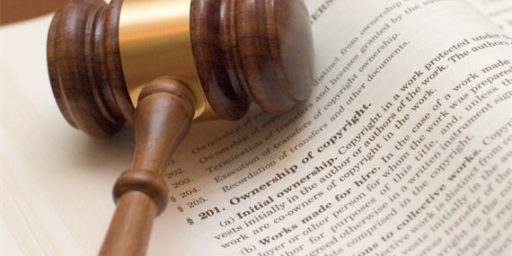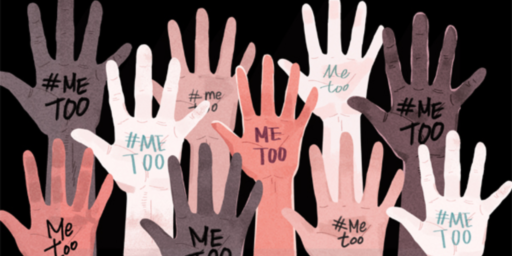King’s “I Have A Dream” Speech Years in Making
Martin Luther King's historic "I Have a Dream" speech was, like a political stump speech, crafted and polished over months and years of delivery.
Nick Gillespie passes along an interesting backstory on Martin Luther King’s iconic “I Have a Dream” speech. It was delivered on 28 August 1963, more than two years before I was born, so I’ve only understood it through the context of my grade school civics courses and, of course, the ubiquitous clips of the speech itself.
I have always thought of it as an original work, sprung upon a large audience for the first time on that day. In truth, it was more like a political stump speech, crafted and polished over months and years of delivery.
King had been drawing on material he used in the “I Have a Dream” speech in his other speeches and sermons for many years. The finale of King’s April 1957 address “A Realistic Look at the Question of Progress in the Area of Race Relations,” envisioned a “new world,” quoted the song “My Country ‘Tis of Thee,” and proclaimed that he had heard “a powerful orator say not so long ago, that… Freedom must ring from every mountain side…. Yes, let it ring from the snow-capped Rockies of Colorado…. Let it ring from Stone Mountain of Georgia. Let it ring from Lookout Mountain of Tennessee. Let it ring from every mountain and hill of Alabama. From every mountainside, let freedom ring” (Papers 4:178─179). King borrowed this final segment from a speech that Archibald Carey, a minister, politician, and King family friend, delivered at the 8 July 1952 Republican National Convention. King capped the 1957 speech by paraphrasing lyrics from the spiritual Free at Last: “And when that happens we will be able to go out and sing a new song: ‘Free at last, free at last, great God almighty, I’m free at last'” (Papers 4:179).
In King’s 1959 sermon “Unfulfilled Hopes,” he describes the life of the apostle Paul as one of “unfulfilled hopes and shattered dreams” (Papers 6:360). He notes that suffering as intense as Paul’s “might make you stronger and bring you closer to the Almighty God,” alluding to a concept he later summarized in “I Have a Dream”: “unearned suffering is redemptive” (Papers 6:366; King, A Call, 84).
In September 1960, King began giving speeches referring directly to the American Dream. In a speech given that month at a conference of the North Carolina branches of the National Association for the Advancement of Colored People, King referred to the unexecuted clauses of the preamble to the U.S. Constitution and spoke of America as “a dream yet unfulfilled,” (Papers 5:508). He advised the crowd that “we must be sure that our struggle is conducted on the highest level of dignity and discipline” and reminded them not to “drink the poisonous wine of hate,” but to use the “way of nonviolence” when taking “direct action” against oppression (Papers 5:510).
King continued to give versions of this speech throughout 1961 and 1962, then calling it “The American Dream.” Two months before the March on Washington, King stood before a throng of 150,000 people at Cobo Hall in Detroit to expound upon making “the American Dream a reality” (King, A Call, 70). King repeatedly exclaimed, “I have a dream this afternoon” (King, A Call, 71). He articulated the words of the prophets Amos and Isaiah, declaring that “justice will roll down like waters, and righteousness like a mighty stream,” for “every valley shall be exalted, and every hill and mountain shall be made low” (King, A Call, 72). As he had done numerous times in the previous two years, King concluded his message imagining the day “when all of God’s children, black men and white men, Jews and Gentiles, Protestants and Catholics, will be able to join hands and sing with the Negroes in the spiritual of old: Free at last! Free at last! Thank God Almighty, we are free at last!” (King, A Call, 73).
As King and his advisors prepared his speech for the conclusion of the 1963 march, he solicited suggestions for the text. Clarence Jones offered a metaphor for the unfulfilled promise of constitutional rights for African Americans, which King incorporated into the final text: “America has defaulted on this promissory note insofar as her citizens of color are concerned” (King, A Call, 82). Several other drafts and suggestions were posed. References to Abraham Lincoln and the Emancipation Proclamation were sustained throughout the countless revisions. King recalled that he did not finish the complete text of the speech until 3:30 A.M. on the morning of August 28.
Later that day, King stood at the podium overlooking the gathering. Although a typescript version of the speech was made available to the press on the morning of the march, King did not merely read his prepared remarks. He later recalled: “I started out reading the speech, and I read it down to a point…the audience response was wonderful that day…. And all of a sudden this thing came to me that…I’d used many times before…. ‘I have a dream.’ And I just felt that I wanted to use it here…I used it, and at that point I just turned aside from the manuscript altogether. I didn’t come back to it” (King, 29 November 1963).
Understanding the evolutionary nature of the speech makes its epic delivery more understandable. It was the speech of a lifetime because he’d spent a lifetime working up to it.





A moment that has lost none of its power with the passage of time…